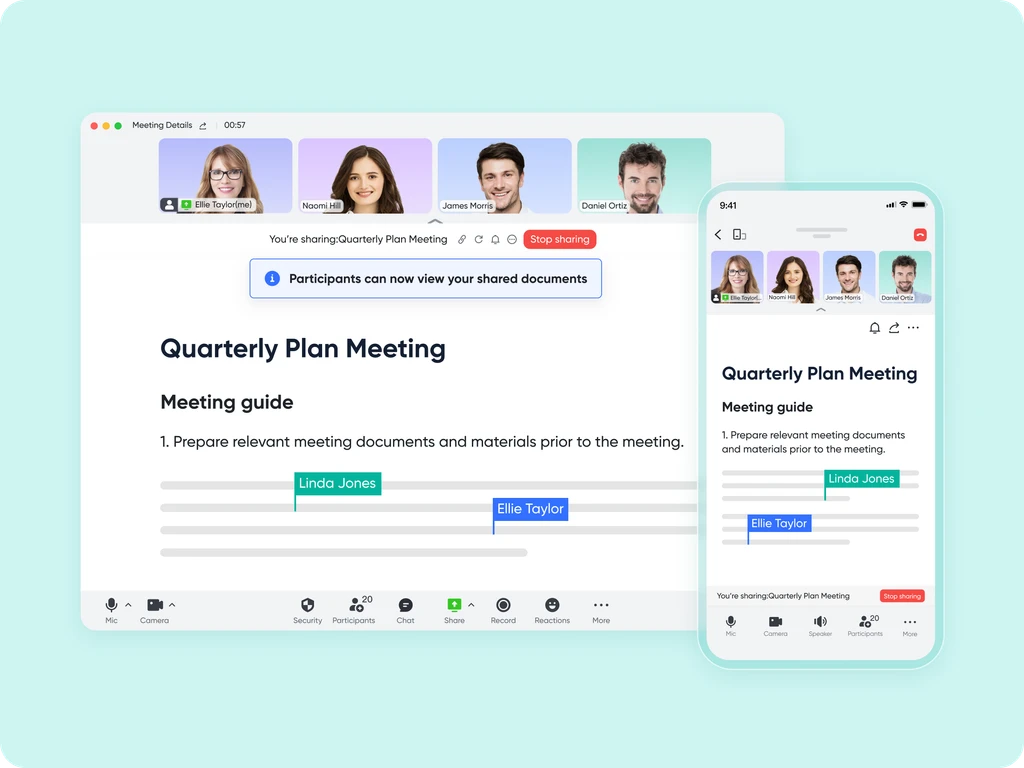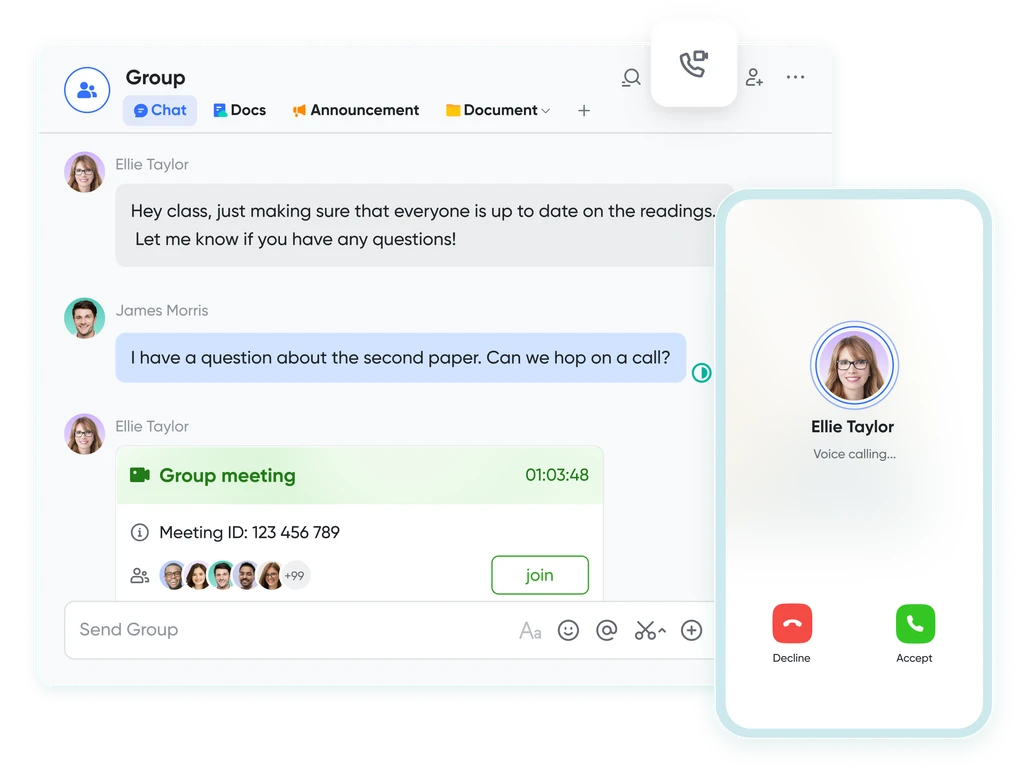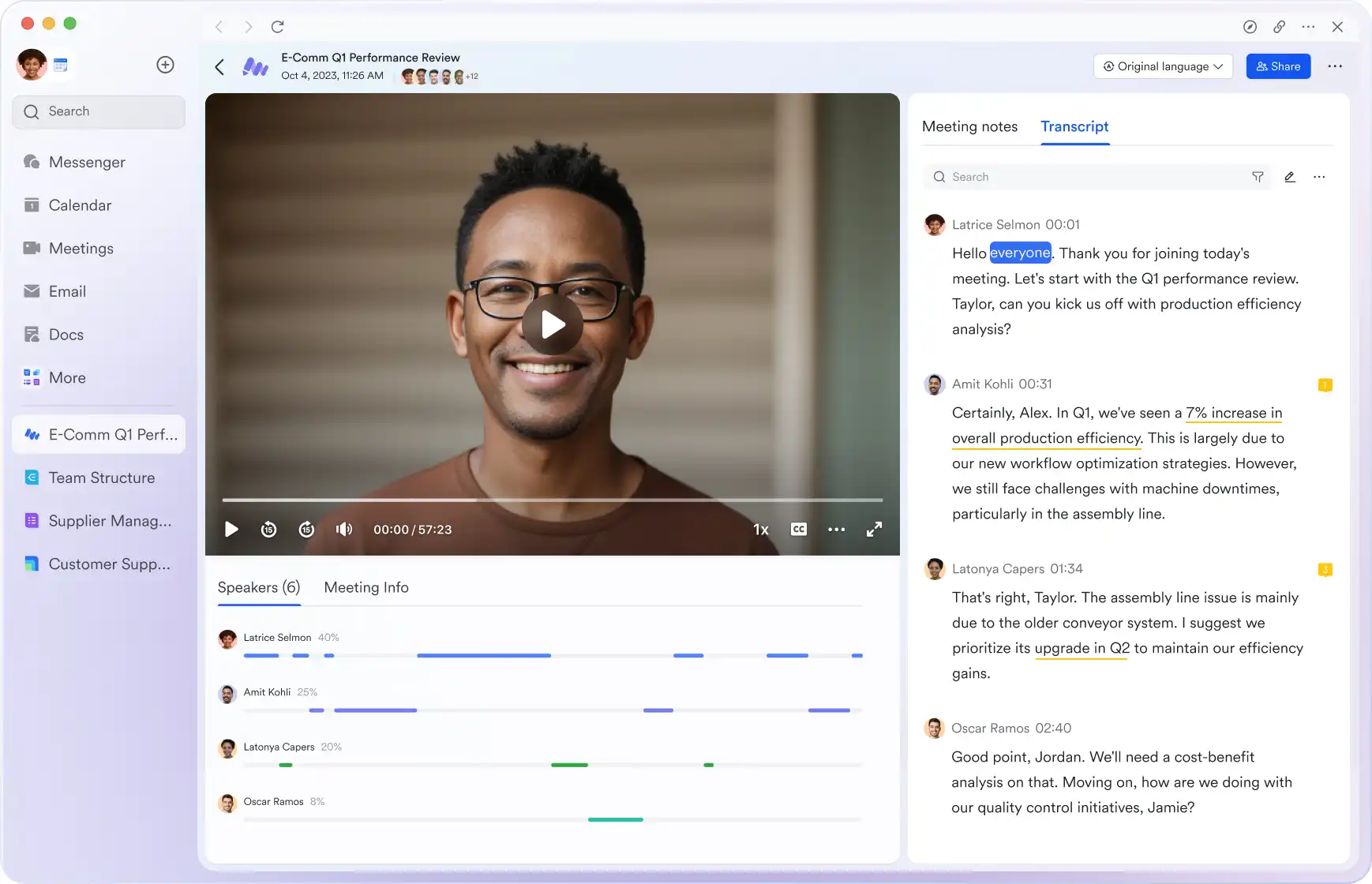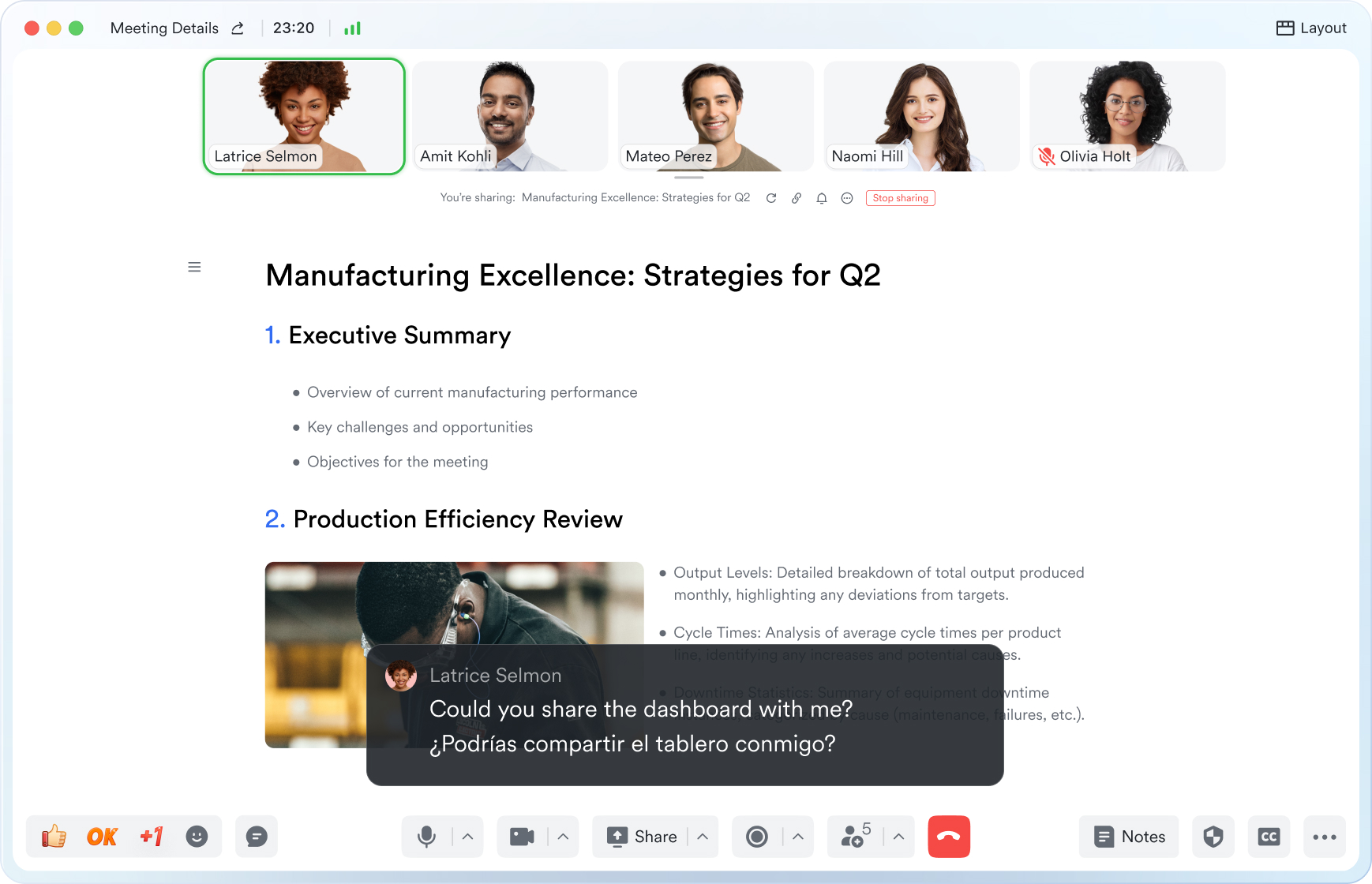Sales Meeting
This guide will walk you through the essential elements of use sales meeting to keep your attendees aligned and engaged.
Try Lark for Free
Sales meetings play a pivotal role in the success of any sales-driven organization. These gatherings provide a platform for sales teams to strategize, collaborate, and align their efforts to achieve revenue targets. A well-executed sales meeting can boost motivation, improve sales techniques, and foster a culture of continuous improvement. In this comprehensive guide, we'll delve into the significance of sales meetings, how to conduct them effectively, and tips for maximizing their impact on your sales efforts.
Use Lark Meetings to turn meetings into true collaborative experiences.
What is a sales meeting?
Understanding Sales Meetings
A sales meeting is a structured gathering of sales professionals within an organization to discuss sales strategies, review performance, set goals, and address challenges. These meetings are typically held regularly and serve as a forum for sharing best practices, market insights, and product updates.
Goals of a sales meeting
Driving Sales Performance and Collaboration
The primary goals of a sales meeting include:
- Performance Review: Evaluating sales team performance and progress towards targets.
- Strategy Alignment: Ensuring that all team members are aligned with the organization's sales strategies.
- Knowledge Sharing: Disseminating important product or market information.
- Motivation: Boosting the team's motivation and enthusiasm.
Who should attend a sales meeting?
Key Participants
Sales meetings involve the following key participants:
- Sales Team: Comprising sales representatives, account executives, and sales managers.
- Sales Manager or Director: Leading the meeting and providing guidance to the team.
- Product Managers or Marketing Representatives: Sharing updates on products, promotions, or marketing strategies.
Learn more about Lark x Meetings
Topics, agenda, and structure of a sales meeting
Structuring the Meeting
A well-structured sales meeting typically includes the following components:
- Opening and Welcome: Setting the tone, objectives, and introducing any guest speakers.
- Performance Review: Discussing sales metrics, individual performance, and goal progress.
- Product Updates: Sharing information about new products, features, or promotions.
- Sales Strategies: Discussing sales strategies, tactics, and upcoming initiatives.
- Sales Training: Providing training on sales techniques, objection handling, or product knowledge.
- Q&A and Discussion: Encouraging questions, feedback, and open discussion.
- Goal Setting: Collaboratively setting sales targets and action plans.
- Motivational Segment: Inspiring the team through success stories or recognition.
- Closing and Next Steps: Summarizing key takeaways, action items, and the meeting schedule.
How to conduct an effective sales meeting?
Step-by-Step Guide
Conducting an effective sales meeting requires adherence to best practices and a well-defined process. Follow these steps for a successful sales meeting:
- Set Clear Objectives: Define the specific objectives and agenda for the meeting.
- Preparation: Ensure that all participants come prepared with relevant data and updates.
- Engage the Team: Encourage active participation, questions, and contributions.
- Data-Driven Discussions: Base discussions on data, including sales metrics, trends, and performance.
- Sales Training: Incorporate training sessions to improve sales techniques and product knowledge.
- Celebrate Successes: Recognize and celebrate individual and team achievements.
- Problem-Solving: Address challenges and obstacles collaboratively.
- Action Planning: Define actionable steps and responsibilities for achieving goals.
- Time Management: Stick to the allocated time for each agenda item.
- Follow-Up: Send meeting minutes, action items, and any relevant materials after the meeting.
Learn more about Lark x Meetings
How often should you hold sales meetings?
Meeting Frequency
The frequency of sales meetings can vary based on the organization's needs and objectives. Common frequencies include:
- Weekly: Suitable for regular updates, goal tracking, and strategy adjustments.
- Bi-Weekly or Monthly: Ideal for broader sales discussions, training sessions, and market updates.
- Quarterly or Annually: Often used for reviewing long-term sales strategies, performance, and goals.
Key differences between sales meetings and similar meetings
Understanding Distinctions
Sales meetings have unique characteristics that distinguish them from other types of gatherings:
- Sales Focus: Sales meetings are dedicated to discussing sales-related topics and strategies.
- Performance Metrics: They heavily rely on sales performance metrics and data.
- Motivational Element: Sales meetings often include motivational segments to boost team morale.
Learn more about Lark x Meetings
Common pitfalls of sales meetings
Avoiding Mistakes
To ensure the success of sales meetings, be cautious of these common pitfalls:
- Lack of Preparation: Holding meetings without adequate preparation or data.
- Overly Lengthy Meetings: Allowing meetings to become excessively long and exhausting.
- Ignoring Performance Metrics: Failing to analyze and address poor sales performance.
- Neglecting Motivation: Forgetting to inspire and motivate the sales team.
Tips for maximizing the impact of sales meetings
Enhancing Effectiveness
To make the most of sales meetings, consider implementing these tips:
- Data-Driven Approach: Base discussions and decisions on sales metrics and market data.
- Interactive Training: Incorporate interactive training sessions to enhance sales skills.
- Goal Setting and Tracking: Collaboratively set and track sales targets and progress.
- Recognition and Rewards: Recognize and reward top performers to boost motivation and morale.
Related:
Unlock the Power of Webinars: A Comprehensive Guide to Boost Your Business | Lark Blog | Lark BlogLearn more about Lark x Meetings
Examples
Real-world scenarios
Real-world scenarios
Let's explore three real-world scenarios of successful sales meetings in various contexts:
Scenario 1: Weekly Sales Team Meeting
Brief Content: A software company holds a weekly sales team meeting to review individual and team performance. The meeting is conducted virtually to accommodate remote team members.
Detailed Content: The meeting begins with a warm welcome and a review of the meeting agenda. The sales manager shares a presentation that includes sales metrics, such as conversion rates, pipeline status, and revenue targets. Team members discuss their achievements, challenges, and strategies for the upcoming week. A guest speaker from the product team provides updates on new features and enhancements. The meeting concludes with a motivational segment, recognizing top performers and setting weekly goals.
Scenario 2: Monthly Sales Training Meeting
Brief Content: A pharmaceutical sales team conducts a monthly training meeting to enhance product knowledge and sales techniques. The meeting takes place in a dedicated training room.
Detailed Content: The meeting starts with an introduction to the training topic, which focuses on a new medication. A product expert delivers an in-depth presentation on the medication's features, benefits, and competitive advantages. Team members participate in role-playing exercises to practice discussing the medication with healthcare professionals. The meeting also includes a discussion on handling objections and addressing common customer concerns. Team members leave the meeting with improved product knowledge and enhanced sales skills.
Scenario 3: Quarterly Sales Strategy Meeting
Brief Content: An e-commerce company holds a quarterly sales strategy meeting to plan for the upcoming quarter. The meeting is conducted at the company's headquarters.
Detailed Content: The meeting begins with an overview of the previous quarter's performance, highlighting successes and areas for improvement. The sales manager presents the company's sales goals for the upcoming quarter, along with specific strategies and initiatives to achieve them. Team members engage in discussions to brainstorm additional ideas and approaches. The meeting includes breakout sessions where teams develop detailed action plans for each strategy. The meeting concludes with a commitment to executing the plans and achieving the set goals.
Tips for do's and don'ts
Best Practices and Pitfalls to Avoid
Follow these do's and don'ts to ensure productive and effective sales meetings:
| Do's | Don'ts |
|---|---|
| Set clear objectives and an organized agenda for each meeting. | Don't allow meetings to become repetitive or lacking in substance. |
| Encourage participation and open discussions among team members. | Avoid focusing solely on negative performance metrics without constructive feedback. |
| Incorporate data-driven discussions and decisions in sales meetings. | Neglect to provide opportunities for training and skill development. |
| Recognize and reward outstanding sales achievements and contributions. | Disregard the importance of motivation and team morale in sales meetings. |
Use Lark Meetings to turn meetings into true collaborative experiences.
A Game Changer for Sales Meeting: Empower your team with Lark Meetings
In the fast-paced and dynamic world of modern business, effective communication and collaboration are crucial for success of Sales Meeting. Here we introduce Lark Meetings to serve as a centralized hub for all communication needs.
Transform your meetings into collaborative endeavors

Leverage the potency of in-call document sharing, intelligent meeting minutes, and mobile-optimized features to enhance productivity collaboratively, irrespective of your location or schedule.
Seamlessly collaborate in real-time, across any device

Share live documents instead of just screen views. Participants can navigate and edit simultaneously within the video call window, even while on the move.
Shift your focus to engagement, not note-taking

Lark Minutes automatically converts video meetings into transcripts, facilitating easy viewing, searching, and collaborative editing. Stay in the loop asynchronously, even if you can't attend the live meeting. Lark Minutes for meeting minutes support translation into 10+ different languages.
Break language barriers in communication

Lark Meetings provide real-time translation for subtitles, allowing individuals from diverse backgrounds to express themselves in their native languages. Ensure every voice is heard, regardless of geographical location. Live subtitles currently support translations from English, Chinese, and Japanese to 10+ different languages. See more translation feature in Lark.
Connect with larger audiences
Host dynamic online meetings and events accommodating up to 1,000 participants, with the flexibility of up to 50 breakout sessions for intimate group discussions within the larger meeting context. Try more Lark features for free.








